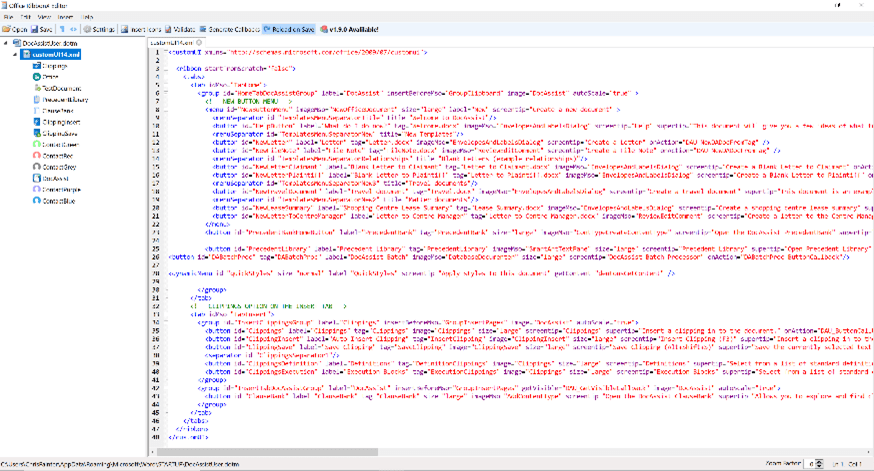Edit or add new DocAssist templates to the Home/New menu in Word
Download and install an Office RibbonX Editor
We recommend using an Office RibbonX Editor for customising the ribbon XML with Word templates. Download the latest version from https://github.com/fernandreu/office-ribbonx-editor
- Backup the DocAssistUser.dotm template
- Close Microsoft Word.
- Create a backup copy of the DocAssistUser.dotm template before making any changes. (We suggest copying the file to a location where you have rights to modify the file, like your Documents directory or the Desktop).
Adding/modifying xml code
- Run Office RibbonX Editor, and open the DocAssistUser.dotm template from the location you copied it to via the Open button.
- In the left pane, double click on the customUI14.xml node, and the CustomXML for the pane should appear in the right hand pane.

- Add the code for the additional DocAssist Word templates to be added to the Word/Home/New menu to the xml file.
- If new templates are required, ensure you add the new DocAssist Word templates in correct location, this is usually under <tab idMso=”TabHome”>
- An existing DocAssist Word template line of xml code can be copied/pasted to add new DocAssist templates.
- Ensure you paste into the location where you want to see the new DocAssist Word templates in the dropdown list.
Breakdown – xml code for adding DocAssist Word templates to Word ribbon
<button id="NewLetter" label="Letter" tag="Letter.docx" imageMso="EnvelopesAndLabelsDialog" screentip="Create a Letter" onAction="DAU_NewDADocFromTag" />- button id name must be unique for each item added
- label is what will appear on the Word ribbon
- tag must be the DocAssist Word template name including Word extension
- imageMso can be any image you choose to select from Microsoft’s inbuilt images, you can Google and download a list.
- screentip will be what appears in an information bubble to user when hovering over item
- onAction this will be the name of the macro (callback) in Word that is called.
“DAU_NewDADocFromTag”. This is the default macro name that takes the value from the Tag in the XML, and uses it to create a new Word document based on the file name.
- Use the Validate button to ensure no issue with code changes. This will highlight errors if any.
- Save and Close xml file.
- With Word still closed, test your changes by copying the Word macro enabled template into the Word start up location specified in the Word Startup Templates path.
- Reopen Word and the New menu should show your modifications to the DocAssist Word templates. If none of the customisations show, then recheck your changes and ensure you Validate the xml before saving. One little typo will make all modifications disappear.
Testing
- Test changes on standard test user setup
- Once tested in user setup – Deploy modified Word macro enabled template and the new DocAssist Word templates, style document/s and/or letterheads (if applicable)